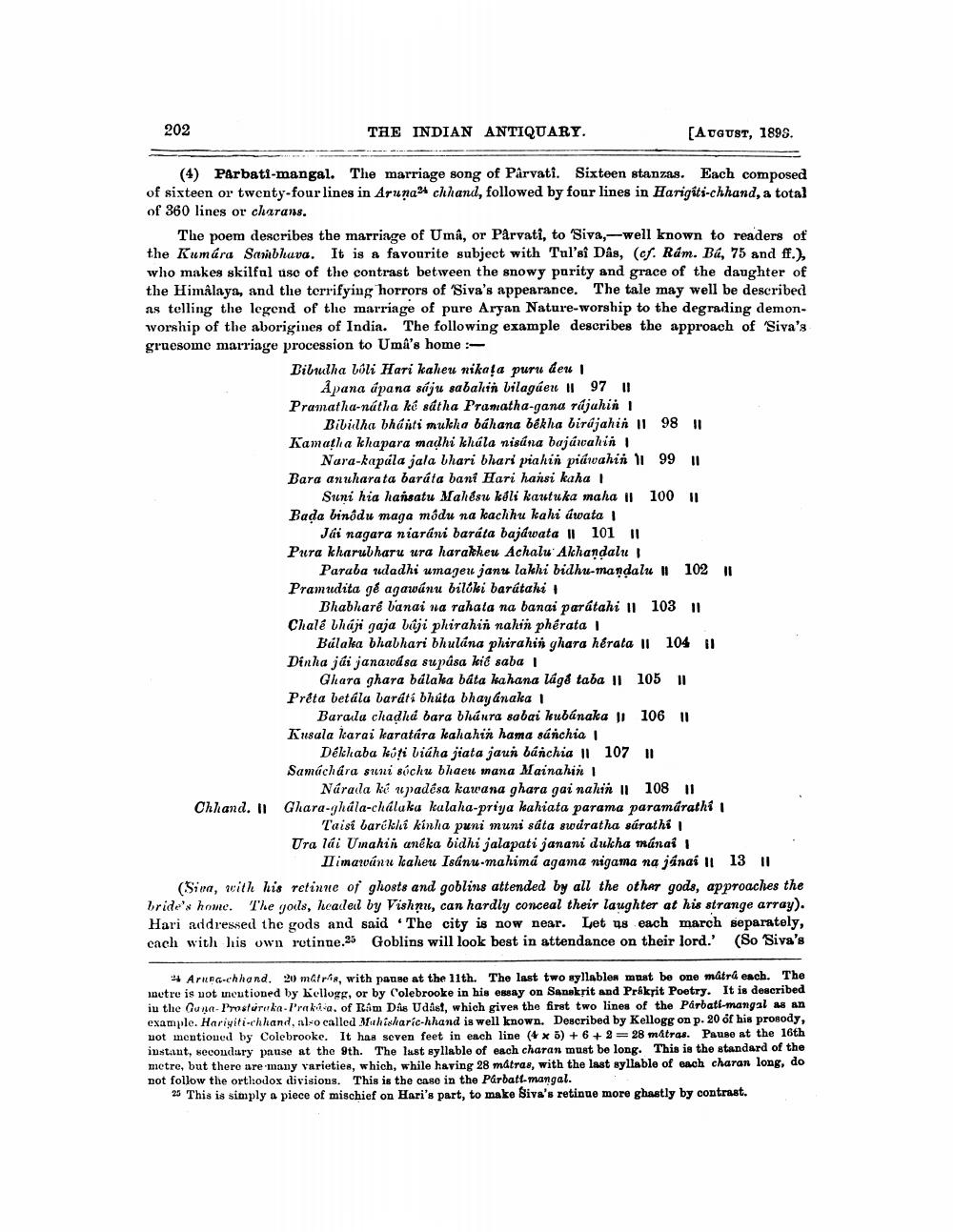________________
202
THE INDIAN ANTIQUARY.
[AUGUST, 1895.
(4) Parbati-mangal. The marriage song of Pârvati. Sixteen stanzas. Each composed of sixteen or twenty-four lines in Aruna chhand, followed by four lines in Harigits-chhand, a total of 360 lines or charans.
The poem describes the marriage of Uma, or Parvati, to 'Siva, -well known to readers of the Kumára Saribhava. It is a favourite subject with Tulsi Das, (cf. Rám. Ba, 75 and ff.). who makes skilfal use of the contrast between the snowy parity and grace of the daughter of the Himalaya, and the terrifying horrors of Siva's appearance. The tale may well be described as telling the legend of the marriage of pure Aryan Nature-worship to the degrading demonworship of the aborigines of India. The following example describes the approach of Siva's gruesome marriage procession to Umi's home :
Dibrulha Coli Hari kaheu nikada puru deu !
Apana úpana súju sabahin vilagher | 97 II Pramatha-nátha ké sátha Pramatha-gana rdjahin
Bibilha bhanti mukha báhana békha birdjahin 11 98 1 Kamatha khapara madhi khála nisána bajawahin!
Nara-kapála jala bhari bhari piahin piúwahin 11 99 II Bara anuharata baráta bani Hari hansi kaha!
Suni hia hansatu Mahésu kali kautuka maha il 100 11 Bada binôdu maga módu na kachhu kahi iwata
Jdi nagara niaráni baráta bajdwata | 101 !! Pura kharubharu ura harakkeu Achalu Akhandalu
Paraba udadhi umageu janu lakhi bidhu-mandalu | 102 II Pramudita ge agawánu bilóki barátahi
Bhabharé banai na rahata na banai parátahi 11 103 II Chalé tháji gaja biji phirahin nahin phêrata
Bálaka bhabhari bhulána phirahin ghara hérata | 104 1 Dinha jái janawása supása kić saba
Ghara ghara bilaka báta kahana lág& taba II 105 II Prêta betala barátí bhíta bhay anaka 1
Barala chadhd bara bhuura sabai kubánaka 11 106 11 Kusala karai karatára kahahin hama sárchia
Dékhaba kofi liáha jiata jaun bánchia || 107 II Samáchára suni sóchu blaeu mana Mainahin
Náraila ke upadésa kawana ghara gai nahin | 108 11 Chhand. 11 Ghara-ghila-chalaka kalaha-priya kahiata parama paramárathi 1
Taisi barékhi kinha puni muni sáta swuratha sárathi Ura lai Umahin aneka bidhi jalapati janani dukha mánai !
Ilimawánu kaheu Isánu-mahima agama nigama na janai 11 13 11 (Sira, with his retinue of ghosts and goblins attended by all the other gods, approaches the bride's home. The goils, healel by Vishnu, can hardly conceal their laughter at his strange array). Hari addressed the gods and said "The city is now near. Let us each march separately, cach with his own rotinue.25 Goblins will look best in attendance on their lord.' (So 'Siva's
# Aruna.chhand. 20 matria, with pause at the 11th. The last two syllablen must be one matr each. The inetre is not incutioned by Kellogg, or by (olebrooke in his essay on Sanskrit and Prikrit Poetry. It is described in the Gume I'rosluruka-Irakva. of Ram Das Udást, which gives the first two lines of the Parbati-mangal as an example. Hariviti-chhand, also called Mahisharic-hhand is well known. Described by Kellogg on p. 20 of his prosody, not mentioned by Colebrooke. It has seven feet in each line (4 x 5) + 6 + 9 = 28 matras. Pause at the 16th instant, secondary pause at the 9th. The last syllable of each charan must be long. This is the standard of the metre, but there are many varieties, which, while having 28 matras, with the last syllable of each charan long, do not follow the orthodox divisions. This is the case in the Parbati-mangal.
25 This is simply a piece of mischief on Hari's part, to make Siva's retinue more ghastly by contrast.




